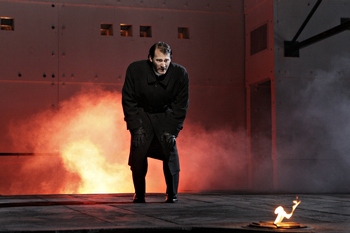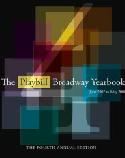SITE GUIDE
SEARCH
REVIEWS
FEATURES
NEWS
Etcetera and
Short Term Listings
LISTINGS
Broadway
Off-Broadway
NYC Restaurants
BOOKS and CDs
OTHER PLACES
Berkshires
London
California
New Jersey
DC
Philadelphia
Elsewhere
QUOTES
TKTS
PLAYWRIGHTS' ALBUMS
LETTERS TO EDITOR
FILM
LINKS
MISCELLANEOUS
Free Updates
Masthead
Writing for Us
A CurtainUp Review
Hamlet
By Les Gutman
|
There is a special providence in the fall of a sparrow. ---Act V, scene 2 |

Michael Stuhlbarg (Photo: Mical Daniel)
|
Having completed his second season as Artistic Director of The Public Theater, Oskar Eustis takes up the gauntlet and marks his debut in the greatest (in New York at least) of places to stage Shakespeare with the greatest of the Bard's plays. In doing so, he has re-established a high water mark in what sometimes seems to have become the land of inexplicable gimmickry and muddled storytelling.
Not lacking in innovative ideas that exploit the unique opportunities that the Central Park setting and the notion of free Shakespeare for the masses present (and more or less demand), Eustis nonetheless remains focused on conveying the story with clarity. What better way to introduce new audiences to the melancholy Dane, and to engage those of us who are not newcomers, than by making it all so understandable, and human? Complicit in his achievement, I should add quickly, is his Hamlet, Michael Stuhlbarg.
This is not to say that the play has been stripped of its complexity or enigma. At the core of Hamlet is a central question: is the boy nuts? To answer the question directly is to wreck the play. Eustis and Stuhlbarg may have a point of view, but they keep it well obscured. Hamlet has moments of trenchant clearheadedness and others of unbridled rage. Whether the former are informing the latter, or the latter, the former, that is the question.
This Hamlet is short on pomp, and Stuhlbarg's speeches similarly are presented without the sense of portentousness that often accompanies them. "To be or not to be" may be the most important existential dilemma expressed in all of literature, but it is also a young man's wrestling with his own fiber. In a recent interview, Stuhlbarg said that he decided to let Hamlet find him, rather than the other way around. The result is a performance that feels human, rather than one in which we witness an actor tackling the greatest and most challenging role he is likely to confront. Still, his performance has no lack of amplitude.
The remainder of the cast includes several high points and several forgettable or unfortunate ones. At the top of the heap is Sam Waterston's windbag of a Polonius, which is both very funny and also affecting. Lauren Ambrose's Ophelia starts weakly, in her major scene with Hamlet especially, but redeems itself mightily as she shreds her hair and dons combat boots enroute to her downward spiral. The Gertrude of Margaret Colin owes a debt to Laura Bush, and though not very memorable, certainly is not deficient either. The latter can also be said of Kevin Carroll's Horatio, which registers far less than some Horatios.
The less happy notes are that Andre Braugher seemed horribly miscast as Claudius, though perhaps it is just that he hasn't figured out who his character is. Nothing he said or did had much to do with what was going on around him and, in stark contrast to my comments about Stuhlbarg above, watching his performance felt like nothing more than witnessing an actor tackling a role. David Harbour also seemed miscast, both in appearance and in temperament. Nothing in the goofball who left for France provided any foundation for his relationship with Opehlia or his actions upon his return.
Among the supporting cast, Jay O. Sanders was the standout. Given three significant roles to play -- the Ghost, the Player King and the Gravedigger -- he made each memorable. The Players here performed as a puppet troupe, making a lasting impression aided by the masterful Basil Twist's puppetry.
Upon entering the Delacorte, I was turned off by David Korin's set, which features a massive white structure consuming the width of the stage. It grew on me, and was put to particularly effective use as Polonius accompanied his son to the steamship on which he left for France, but overall remained an unnecessary (and irrelevant) intrusion. The stage also featured an "eternal flame," conjuring up the Kennedy gravesite. Oskar Eustis's program notes reminded us that the play "is both a domestic and a political story," and that the "tragedy of Hamlet is also the tragedy of Denmark." This image, married with a shocking and no doubt controversial coda, bring the latter into a frame of reference to which we can relate.
Ann Hould-Ward designed costumes of great and thoughtful subtlety, unconstrained by period but exactingly reflective of the text. Michael Chybowski lit the show very effectively, though I found the choice of fluorescent lighting to denote interior scenes in the palace odd, underscoring rather than erasing the effects of the white elephant of a set. Acme Sound Partners delivered sound that was anything but subtle, though no more disruptive than is perhaps possible considering the Delacorte's inherent issues, while Mark Bennett's music made little impression of note.
Any production of Hamlet carries with it the burden of Hamlets past. This one felt at once fresh and yet faithful.
| HAMLET By William Shakespeare Directed by Oskar Eustis with Lauren Ambrose, Christopher Bonewitz, Andre Braugher, Bruce Cannon, Matt Carlson, Kevin Carroll, Margaret Colin, W. Tre Davis, Emily DeCola, David Harbour, Stephen James King, Hoon Lee, Dana Lyn, Piter Marek, Greg McFadden, Julio Monge, Paul O'Brien, Erin Orr, Gilbert Owuor, Jay O. Sanders, Michael Schupbach, Miriam Silverman, Michael Stuhlbarg and Sam Waterston. Set Design: David Korins Costume Design: Ann Hould-Ward Lighting Design: Michael Chybowski Sound Design: Acme Sound Partners Composer: Mark Bennett Puppetry: Basil Twist Fight Choreographer: Thomas Schall Running Time: 3 hours, 20 minutes including one intermission A production of The Public Theater Delacorte Theatre, Central Park (enter park @81st Street/CPW or 79th/5 Av.) Telephone (212) 539-8750 Public Theater website: www.publictheater.org Opening June 17, 2008, closes June 29, 2008 Tues - Sun @8:00 (added perf 6/23 (limited ticket distribution), no perf 6/18 or 6/24, 6/19 perf @8:30 and no distribution (stand-by line only) on 6/ 17; Free, limit of 2 per person (ticket pickup at the Delacorte, also limited tickets online, no tickets at The Public. Tickets in all 5 boroughs on specified days -- see The Public Theater website for details on all options) Reviewed by Les Gutman based on 6/12/08 performance |
|
REVIEW FEEDBACK Highlight one of the responses below and click "copy" or"CTRL+C"
Paste the highlighted text into the subject line (CTRL+ V): Feel free to add detailed comments in the body of the email and state if you'd like your comments published in our letters section. |
Try onlineseats.com for great seats to
Wicked
Jersey Boys
The Little Mermaid
Lion King
Shrek The Musical

South Pacific

In the Heights

Playbill 2007-08 Yearbook

Leonard Maltin's 2008 Movie Guide


Wicked
Jersey Boys
The Little Mermaid
Lion King
Shrek The Musical

South Pacific

In the Heights

Playbill 2007-08 Yearbook

Leonard Maltin's 2008 Movie Guide


